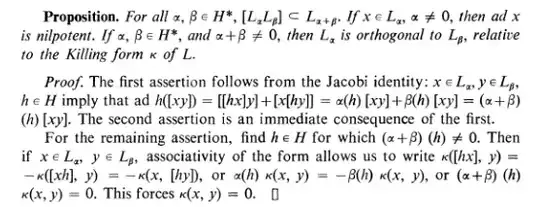$ \DeclareMathOperator{\ad}{ad}$ Let $L$ be a semisimple Lie algebra with root space $L=H \oplus \bigoplus_{\alpha \in \Phi}L_\alpha$. Let $x\in L_\alpha$ with $\alpha\neq 0$. I want to show
Then $\ad x $ is nilpotent.
I know that if $\alpha, \beta\in H^*$ then $[L_\alpha,L_\beta]\subset L_{\alpha+\beta}$. I think I should make if we could show that there are only finitely many non-zero $L_\alpha$, we could use this fact to push $x$ into a trivial root space. Then it should follow that $(\ad x)$ is nilpotent? I am slightly confused as to what it means for $(\ad x)$ to be nilpotent, is it that $(\ad x)^n$ is zero, or is it that $\ad^n x$ is zero?
Note this is a Proposition in Humphreys book but I do not see how it follows directly.
